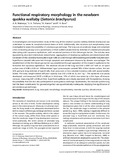| dc.contributor.author | Makanya, AN | |
| dc.contributor.author | Tschanz, SA | |
| dc.contributor.author | Burri, PH | |
| dc.contributor.author | Haenni, B | |
| dc.date.accessioned | 2013-07-25T06:20:20Z | |
| dc.date.available | 2013-07-25T06:20:20Z | |
| dc.date.issued | 2007 | |
| dc.identifier.citation | Journal of Anatomy Volume 211, Issue 1, pages 26–36, July 2007 | en |
| dc.identifier.uri | http://onlinelibrary.wiley.com/doi/10.1111/j.1469-7580.2007.00744.x/pdf | |
| dc.identifier.uri | http://erepository.uonbi.ac.ke:8080/xmlui/handle/123456789/50850 | |
| dc.description.abstract | A morphological and morphometric study of the lung of the newborn quokka wallaby (
Setonix brachyurus
) was
undertaken to assess its morphofunctional status at birth. Additionally, skin structure and morphometry were
investigated to assess the possibility of cutaneous gas exchange. The lung was at canalicular stage and comprised
a few conducting airways and a parenchyma of thick-walled tubules lined by stretches of cuboidal pneumocytes
alternating with squamous epithelium, with occasional portions of thin blood–gas barrier. The tubules were
separated by abundant intertubular mesenchyme, aggregations of developing capillaries and mesenchymal cells.
Conversion of the cuboidal pneumocytes to type I cells occurred through cell broadening and lamellar body extrusion.
Superfluous cuboidal cells were lost through apoptosis and subsequent clearance by alveolar macrophages. The
establishment of the thin blood–gas barrier was established through apposition of the incipient capillaries to the
formative thin squamous epithelium. The absolute volume of the lung was 0.02 ± 0.001 cm
3
with an air space
surface area of 4.85 ± 0.43 cm
2
. Differentiated type I pneumocytes covered 78% of the tubular surface, the rest
22% going to long stretches of type II cells, their precursors or low cuboidal transitory cells with sparse lamellar
bodies. The body weight-related diffusion capacity was 2.52 ± 0.56 mL O
2
min
–1
kg
–1
. The epidermis was poorly
developed, and measured 29.97 ± 4.88
μ
m in thickness, 13% of which was taken by a thin layer of stratum
corneum, measuring 4.87 ± 0.98
μ
m thick. Superficial capillaries were closely associated with the epidermis, showing
the possibility that the skin also participated in some gaseous exchange. Qualitatively, the neonate quokka lung
had the basic constituents for gas exchange but was quantitatively inadequate, implying the significance of
percutaneous gas exchange. | en |
| dc.language.iso | en | en |
| dc.publisher | Wiley | en |
| dc.subject | Development | en |
| dc.subject | Lung | en |
| dc.subject | Marsupial | en |
| dc.subject | Morphology | en |
| dc.subject | Morphometry | en |
| dc.subject | Neonate | en |
| dc.subject | Quokka | en |
| dc.subject | Ultrastructure | en |
| dc.title | Functional respiratory morphology in the newborn quokka wallaby (Setonix brachyurus) | en |
| dc.type | Article | en |
| local.publisher | Department of Veterinary Anatomy & Physiology, University of Nairobi, Kenya | en |
| local.publisher | Institute of Anatomy, University of Berne, Switzerland | en |

